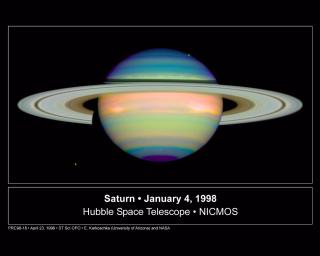
|
An Infrared View of Saturn
- Click the image above for a larger view
- Full-Res JPEG (1125 x 900) (58.7 kB)
- Full-Res TIFF (1125 x 900) (666.6 kB)
Caption:
In honor of NASA Hubble Space Telescope's eighth anniversary, we have gift wrapped Saturn in vivid colors. Actually, this image is courtesy of the new Near Infrared Camera and Multi-Object Spectrometer (NICMOS), which has taken its first peek at Saturn. The false-color image - taken Jan. 4, 1998 - shows the planet's reflected infrared light. This view provides detailed information on the clouds and hazes in Saturn's atmosphere.
The blue colors indicate a clear atmosphere down to a main cloud layer. Different shadings of blue indicate variations in the cloud particles, in size or chemical composition. The cloud particles are believed to be ammonia ice crystals. Most of the northern hemisphere that is visible above the rings is relatively clear. The dark region around the south pole at the bottom indicates a big hole in the main cloud layer.
The green and yellow colors indicate a haze above the main cloud layer. The haze is thin where the colors are green but thick where they are yellow. Most of the southern hemisphere (the lower part of Saturn) is quite hazy. These layers are aligned with latitude lines, due to Saturn's east-west winds.
The red and orange colors indicate clouds reaching up high into the atmosphere. Red clouds are even higher than orange clouds. The densest regions of two storms near Saturn's equator appear white. On Earth, the storms with the highest clouds are also found in tropical latitudes. The smaller storm on the left is about as large as the Earth, and larger storms have been recorded on Saturn in 1990 and 1994.
The rings, made up of chunks of ice, are as white as images of ice taken in visible light. However, in the infrared, water absorption causes various colorations. The most obvious is the brown color of the innermost ring. The rings cast their shadow onto Saturn. The bright line seen within this shadow is sunlight shining through the Cassini Division, the separation between the two bright rings. It is best observed on the left side, just above the rings. This view is possible due to a rare geometry during the observation. The next time this observable from Earth will be in 2006. An accurate investigation of the ring's shadow also shows sunlight shining through the Encke Gap, a thin division very close to the outer edge of the ring system.
Two of Saturn's satellites were recorded, Dione on the lower left and Tethys on the upper right. Tethys is just ending its transit across the disk of Saturn. They appear in different colors, yellow and green, indicating different conditions on their icy surfaces.
Wavelengths: A color image consists of three exposures (or three film layers). For visible true-color images, the wavelengths of these three exposures are 0.4, 0.5, and 0.6 micrometers for blue, green, and red light, respectively. This Saturn image was taken at longer infrared wavelengths of 1.0, 1.8, and 2.1 micrometers, displayed as blue, green, and red. Reflected sunlight is seen at all these wavelengths, since Saturn's own heat glows only at wavelengths above 4 micrometers.
Background Info:
The Wide Field/Planetary Camera 2 was developed by the Jet Propulsion Laboratory and managed by the Goddard Space Flight Center for NASA's Office of Space Science.
This image and other images and data received from the Hubble Space Telescope are posted on the World Wide Web on the Space Telescope Science Institute home page at URL http://oposite.stsci.edu/ .
Cataloging Keywords:
| Name | Value | Additional Values |
|---|---|---|
| Target | Saturn | Cassini Division, Dione, Encke Gap, Saturn Rings, Tethys |
| System | Saturn | |
| Target Type | Planet | Gap, Ring, Satellite |
| Mission | Hubble Space Telescope (HST) | |
| Instrument Host | Hubble Space Telescope | |
| Host Type | Space Telescope | |
| Instrument | Wide Field/Planetary Camera 2 (WFPC2) | Near Infrared Camera and Multi-Object Spectrometer (NICMOS) |
| Detector | ||
| Extra Keywords | Ammonia, Atmosphere, Color, Haze, Infrared, Shadow, Storm, Visual, Water, Wave | |
| Acquisition Date | ||
| Release Date | 1998-08-02 | |
| Date in Caption | 1998-01-04 | |
| Image Credit | NASA/JPL/STScI | |
| Source | photojournal.jpl.nasa.gov/catalog/PIA01268 | |
| Identifier | PIA01268 | |
